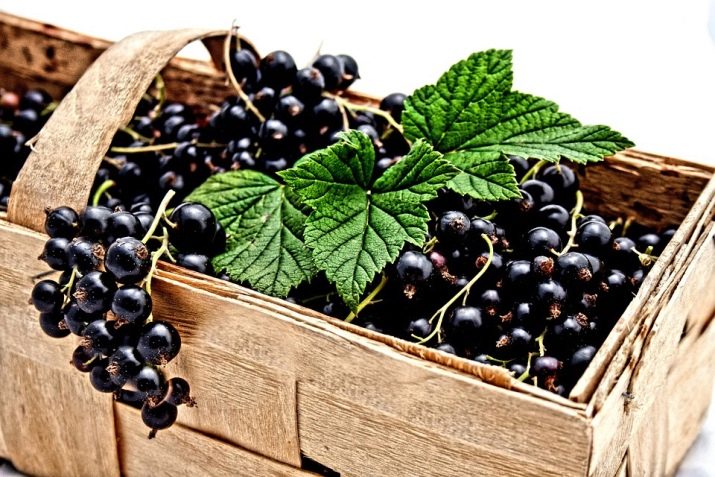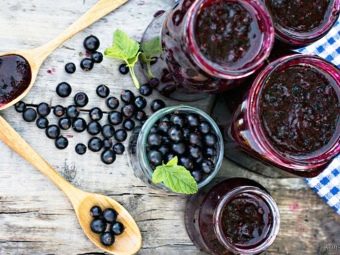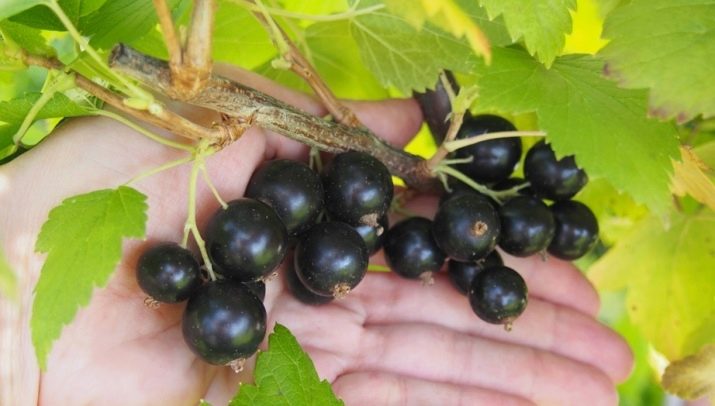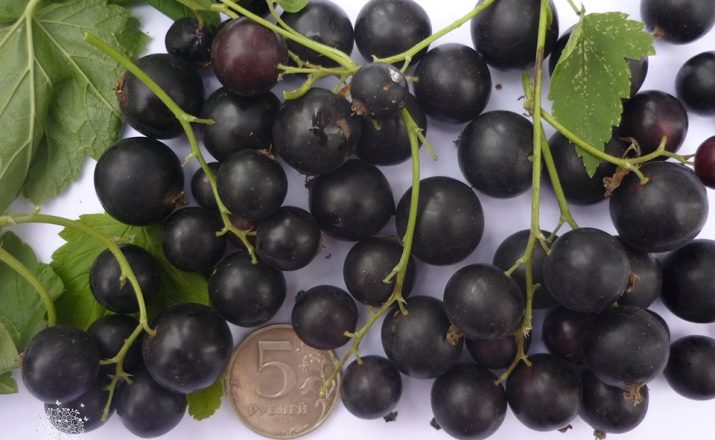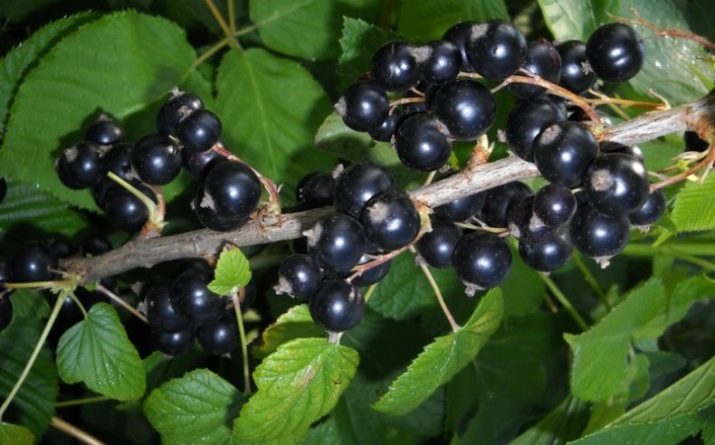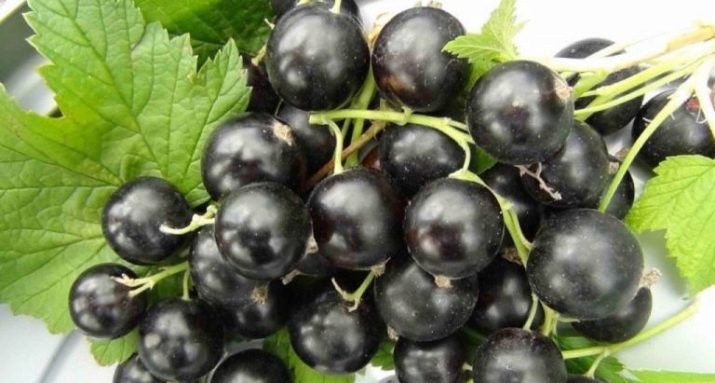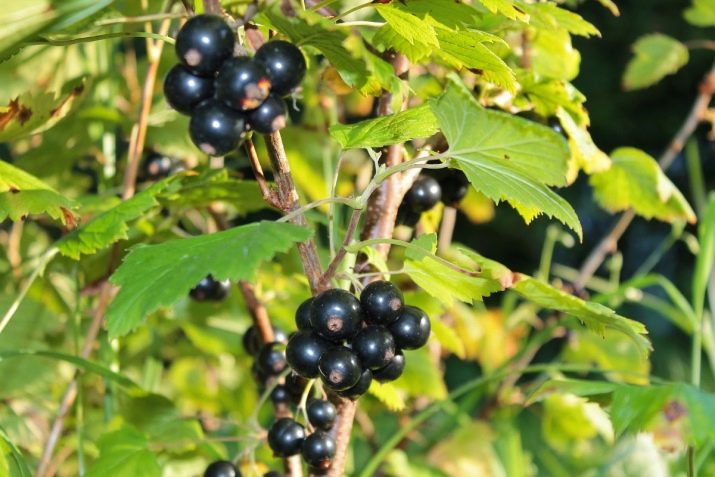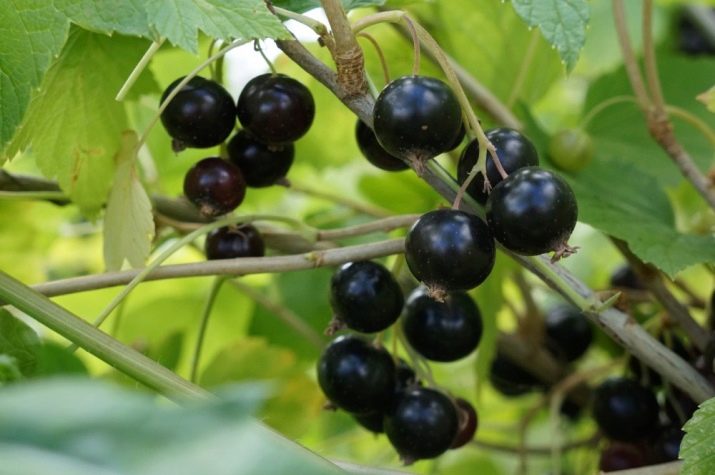Types and the best varieties of black currant
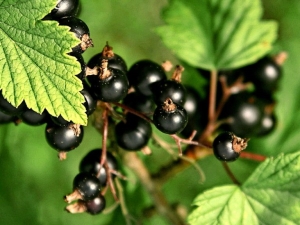
In the recent past, the preservation of berries grown on their plots was a necessity.In order to get vitamins and minerals contained in berries and fruits, it was necessary to save them for the winter in the form of jam, compote or other dessert. Today, a resident of any city and village has the opportunity to come to the store and purchase any jam, jelly and even fresh berries brought from hotter countries.
However, the composition of these products is often not encouraging, since it contains a large amount of harmful additives and too much sugar. Because of this, many gardeners continue to grow and preserve their own products. One of the most common berries growing in our short summer is black currant.
Culture description
Black currant (Ribes nigrum) is a plant of the gooseberry family, which is also called the “Alpine” or “gout” berry. The bush with a height of 1 to 2 meters has three- or five-lobed leaves up to 12 cm long. On the back of the leaf are oil glands. Young soft shoots have a white shade and a small down, and adults - more solid and have a brown tint. The inflorescences have the shape of a drooping brush with several yellowish and brownish flowers. The fruits in the process of ripening change color from reddish brown to black.
Currant blossoms in the period from mid-April to late May, loves high humidity and the neighborhood with deciduous and coniferous trees. In the natural environment often grows along the banks of rivers, marshes and in floodplain meadows. Most often, the bushes form a small thickets, but there is a single currant. It grows throughout Europe, as well as in China and Mongolia. In culinary and pharmaceutical, both ripe fruits and leaves or buds are used. The leaves of the alpine berries are harvested from the beginning of flowering and up to the leaf fall. They are collected from the middle of the bush, so as not to disrupt the process of fruiting, and dried in the sun.
Kidneys are collected in late February and are used to prepare various medicinal tinctures. And the fruits themselves can be collected in the second half of summer as they darken. The yield of one bush depends on the variety and can reach 3-4 kilograms of black berries.
The cultivation and cultivation of currants in large quantities due to the fact that it has a rich in nutrients composition. At the same time, the calorie content of the berry, in comparison with others, is quite low: only 44 kcal per 100 g. The nutritional value of black currant fruits is 1 g of protein, 0.3 g of fat and 8 g of carbohydrates. At the same time, it contains:
- vitamins of group B (B9, B5, B1, B2, B6), vitamin A, C, E, ZZ, N;
- macronutrients: potassium, magnesium, chlorine, phosphorus, calcium;
- trace elements; iodine, zinc, iron, copper, cobalt, manganese, fluorine;
- saturated and unsaturated fatty acids;
- di- and monosaccharides;
- organic acids.
Any housewife has several recipes for cooking and preserving black currant. It can be jam or jam, compote or jelly, juice and berry puree. Fresh berry is put in pastries and fruit salads, it is added to ice cream and eaten as a separate dish. Currant leaves are often used when salting vegetables to add flavor and savor to brine. Dried leaves are brewed in boiling water or added to the finished mixture of herbs and tea.
In addition to cooking, blackcurrant is often used as a medicine. The high content of vitamin C makes this black berry an indispensable aid in the fight against colds and viral diseases. Only a few berries every day will serve as a good prevention of angina or flu and enhance immunity. Decoction of currant leaves reduces inflammation and relieves fever, positively affect the human nervous system.
Tea with currant leaves will help relieve tension and give a healthy deep sleep. The diuretic effect of currant juice is often used in the treatment of cystitis and diseases of the urogenital system.Jam or jam gently reduces the acidity of the stomach, and therefore is indicated for frequent heartburn.
Black currant is a natural salvation for people with diabetes. It is able to quickly normalize blood sugar levels. In addition, a decoction of buds and leaves of currants copes with swelling in the intestines and diarrhea. According to many women, this tool also helps to reduce pain and spasm during menstruation. In addition, the use of fresh berries of currant is necessary for pregnant women in the early and middle periods. Vitamin berry reduces the risk of developing pathologies of the nervous system of the fetus.
Currants are used not only in medicine, but also in home cosmetology. Its juice, even though it is black, has a strong whitening effect. It is often applied to the skin of the face or hands to get rid of age spots. In addition, currant juice favorably affects the nail plate. If you lubricate them with a dark liquid for 3-4 weeks, you can forget about the fragility and delamination of nails.
Contraindications for eating berries is not so much, but still they are. First, it is an individual intolerance of a product or an allergy. Secondly, with the tendency to thrombosis currant use is strictly prohibited. This is due to the fact that it sufficiently increases blood clotting. Thirdly, you should not be carried away by currant desserts for people suffering from a stomach ulcer.
Classification
There are many different varieties of currant bushes. All of them can be divided into separate groups depending on the classification. Most often, in various catalogs and stores, berries are divided by ripening terms.
- Early - the first fruits appear already at the end of June.
- Average - Berry picking can be started from the end of the second summer month.
- Late and very late. Such currants are harvested at the end of summer, at the beginning and even in the middle of autumn.
One of the important characteristics of currants is its purpose. Depending on this variety is divided into the following types.
- Dessert - the most sweet and juicy berries, which are most often consumed fresh or ground in mashed potatoes.
- For conservation. This currant is more acidic in taste and at the same time has a thinner skin. Due to its subtlety, sugar embedded in the recipe penetrates into the berry, and canned fruits are no less sweet than dessert varieties.
- For freezing. Holders of large freezers can afford to preserve fruits and berries not in the form of jam or compote, but in freezing. This will keep the maximum amount of nutrients and the initial taste of the fruit. So that the frozen berry does not burst and does not crumple, such varieties have a more dense skin.
- Universal. These varieties combine in themselves some qualities of others and are suitable for storage in any form. At the same time, the universal currant will never be sweeter than the dessert, but it is more pleasant to use it fresh than those varieties that are intended solely for preservation.
- Decorative. Not all people who have a country house grow vegetables and berries on their land. Someone uses the space of his garden exclusively in the form of a recreation area or for receiving guests in the summer. For them, the appearance of the plant is much more important than the taste and quantity of its fruits. In this regard, special ornamental varieties of currants were bred, which bear little fruit, while its leaves have a beautiful color - from lettuce to dark green and even burgundy.
In addition, black currant can be grouped by grade, depending on the size of its fruit or the amount of the crop. Also important indicators by which the diversity of varieties can be divided into groups is the resistance of the shrub to critical temperatures and to various diseases.
Popular varieties
There is no one correct grade of currant which would be suitable for any conditions and for any processing.Even universal varieties can vary greatly among themselves in some indicators. Varieties suitable for the middle band, for example, for the Moscow region, are absolutely not suitable for cultivation in Siberia. They will bear little fruit, the berry will not grow in cold summer conditions, and in winter it may just die. At the same time, even small climate changes, for example, high humidity characteristic of the Leningrad Region, can affect the quantity and quality of the crop.
However, there are varieties of berries that are more popular than others. This is due to the fact that in the northern and southern regions gardeners prefer to grow those varieties whose fruits ripen before the others, have a larger size and a sweeter taste.
Large fruit
Black currant varieties with large fruits are more attractive due to their high yields. Brushes of such a bush are so heavy that they look like a bunch of grapes. In return, they require better quality care, namely frequent watering. If the amount of moisture is not enough, the fruits will be small and immature. It is harder to keep such berries, because their peel breaks easily under the weight of the pulp, so they are most often consumed fresh or as a puree.
Large berries ripen well on those branches that have grown no less than 20-30 cm in a year. In this regard, it is necessary to timely trim those shoots that have a weak growth over 3-5 years. Large-fruited varieties come in both early and late ripening, so they are selected depending on the region and personal preferences. Almost all popular large-fruited varieties are also winter-resistant, since winters in our country are cold and snowy in most parts of the region.
"Vigorous"
Mid-season shrub, the crop from which can be collected in the middle and late July. The weight of one berry reaches 6 grams, on one brush 8-12 berries are harvested. From 20-30 brushes you can collect about 1 kg of the crop, and from 4 to 6 kg from the whole bush. The taste of "Yadrenoy" - sweet with a slight sour aftertaste. Due to such a high yield, the plant needs regular rejuvenation by pruning old shoots. Depending on the quality of care currant can live from 4 to 7 years, after which it will require full replacement with a young plant.
"Black Pearl" ("Black Pearl")
Medium early large-fruited currants, at one time received the title "Masterpiece of Russian selection." The weight and taste of the berries are similar to the previous variety and contain 9.5% of sugars. From each shrub can be collected from 4 to 5 kg of berries. The fruits have a very dense skin with a slight luster, resembling the pearl of pearls, for which they got their name. The high density of the peel makes it easy to separate the ripe pearl from the brush.
During transportation and storage there is less risk of mashing and bursting berries. The only disadvantage of the variety is its low resistance to the fungus and various insects.
"Selechenskaya-2"
Early currant fruits large (up to 6 g) sour-sweet berries with dense skin and bright aroma. A brush can contain up to 15 berries, and the whole bush produces crops weighing up to 5 kg. The shrub is quite high compared to other varieties, reaching 2 meters. "Selechenskaya-2" is unpretentious, can withstand both extreme heat and cold. In addition, this currant is resistant to lack of moisture, but requires a large amount of fertilizer and often dies from pests.
"Pygmy"
The weight of one berry of this medium early bush can reach 8 grams, and up to 10 pieces can be placed on one brush. One of the distinguishing features of this variety is the preservation of the large size of the fruit during the aging of the shrub itself. To taste, currants can be attributed to sweet varieties, and the yield per season can reach 7-8 kg. The bush has a height of 1.5 to 2 meters, but it is quite narrow and does not take up much space on the site."Pygmy" often suffers from infection with septoria or tick raids. At the same time it is resistant to dew and cold, and also has the ability of self-pollination.
"Summer Resident"
Early ripe shrub with berries weighing up to 5 g gives a fairly small crop. In total, about 1.5–2 kg of fruit can be obtained from one currant per season. At the same time, this quantity practically does not depend on the quality of care, only the weight of one berry. The branches of the shrub are very short, so heavy brushes incline them almost to the ground itself. So that the berry does not get dirty and is not eaten by various bugs, it is necessary to install supports under the extreme shoots.
If the fruits are not harvested immediately after ripening, they will quickly begin to fall from the brush.
"Dobrynya"
Mid-season variety with a weight of berries about 6-7 grams. On the brush can be found from 8 to 12 berries, and the yield of one bush is about 3-4 kg. The sweet-sour taste and thick skin of the berry allow it to be used both in compote and for freezing. The crown of the bush reaches a height of 1.5-1.7 meters, it is compact, the branches do not sag under the weight of the berries. The variety is resistant to temperature and dew, but is often affected by fungus and requires more careful care.
"Titania"
Sweet berries have an average size and weight of about 4 grams each. However, there may be from 20 to 25 pieces on their brush. Due to this, the yield of one bush can be from 3 to 4 kg per season. The sweet and sour taste is due to the low sugar content (only about 6%), and ripening occurs gradually in small batches. With good care and abundant regular watering, “Titania” copes well with diseases and pests without loss of yield. Sharp temperature drops are also not afraid of this variety.
Sweet
Sweet (or dessert) varieties of currants contain from 8 percent or more of sugar. If there is a slight sourness due to the high content of vitamin C, then it feels like a slight aftertaste. This currant resembles grapes or ripe plum. The rind of dessert varieties is almost always dense, as their sweetness is too attractive for insects. There are several popular dessert varieties that are distributed almost throughout the country.
"Gulliver"
The weight of one berry of the early "Gulliver" can reach 5 grams, while there may be about 20 of them on a brush. In a year one bush produces about 2 kg of sweet-sour fruits. It is resistant to cold, rot and mites, but requires good lighting and abundant watering. In dry areas with a lack of moisture, both the quantity and the quality of the crop falls dramatically.
"Bagheera"
The high yield and large size of mid-season “Bagira” make this variety one of the most popular. The fruits ripen at one time and are great for both personal use and for sale. Berries contain up to 12% sugar in the composition and have a strong aroma. Among the disadvantages of Bagira, it is possible to distinguish low resistance to pests and dew, but this currant tolerates temperature drops very easily.
"Lazy person"
Late-ripening variety has small fruits (2-3 grams) with a black-brown shade. The high content of both sugar and vitamin C gives the berries a sweet taste with a slight sour aftertaste. Currant brushes are small, with 8-10 fruits, have a strong aroma and attractive appetizing look. Berries ripen alternately in several batches, so they will have to be collected throughout August.
After ripening, the berries fall off, not remaining on the bush. The name of the variety received for the fact that the berries can be collected using various tools or machines, as the foliage and brush are not as thick as other varieties. "Lazy" tolerates low temperatures and is resistant to diseases and insect attacks.
"Vologda"
Late-ripening sweet currant of this variety has bright acidity and is more often used for preservation. The mass of one fruit reaches 3 grams, and the yield of the bush varies from 3 to 4 kg.The ripening is uneven and stretched for the whole of August, capturing the warm days of September, so the berry is collected in several approaches. Ripe fruits are not showered for a long time with a brush, but often crack, due to which they become unsuitable for storage and preservation.
The variety is self-pollinating and does not require additional plantings. "Vologda" is resistant to temperatures and diseases, and the young plant begins to bear fruit in the second year.
Early
"Raisin"
An unusual variety of early ripe currants got its name because after ripening the berries do not crumble, but remain on the brush. Under the rays of the sun, they wither and shrivel, becoming like raisins. The weight of one berry ranges from 4-5 grams, but almost all of them grow to it, leaving no small fruits. From one bush can be collected about 3.5-4 kg of fruit of sweet taste. The shoots of the plant are drawn vertically, thereby greatly saving space on the site.
"Raisin" currants resistant to temperature extremes, fungus and insects. Wherein it is very difficult to reproduce, because the cuttings do not take root well in a new place.
"Exotic"
Small berries have a weight of about 3 grams, the yield of one bush is about 2 kg per season. From 8 to 12 fruits can be found on one brush, while the shrub itself is not prone to thickening even after several years. "Exotic" is resistant to dew and cold, berries are stored for a long time in fresh form. The shoots are long, therefore they require supports or garters.
"Gross"
Small black berries weighing from 1.5 to 2.5 grams each have a strong aroma and dense pulp of sweet-sour taste. Almost all of them have the same size and shape. The yield of one bush is about 3-4 kg per season, and the peak of fruiting begins at the 3rd year of plant life. Frost-resistant variety with high immunity is often grown on an industrial scale, as the variety is self-fertile. As the bush grows, the yield gradually decreases, but still remains at a decent level.
In order to prevent diseases of currant bushes, it is necessary to carefully care for the plant, to prune old branches and autumn digging of the nearest ground. It is necessary to timely apply the necessary fertilizers to the soil and process the greens from pests with special preparations.
To prevent the occurrence of a fungus, it is necessary to prevent stagnation of water in the soil, and in dry weather, on the contrary, to conduct regular watering. The better the care of the currants, the better and better harvest will delight the shrub. The juicy and sweet berry will become the guest of the table not only in summer, but throughout the year in the form of various desserts, which are so well suited to family tea in cold and dark winter evenings.
For information on the types and varieties of black currant, see below.

